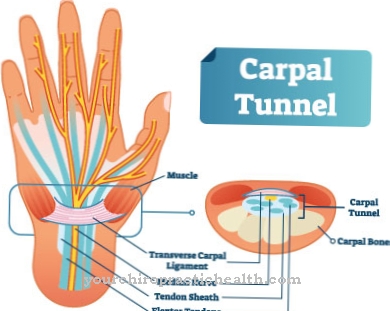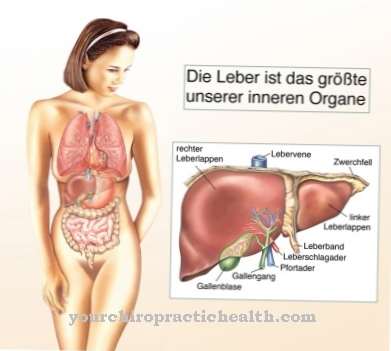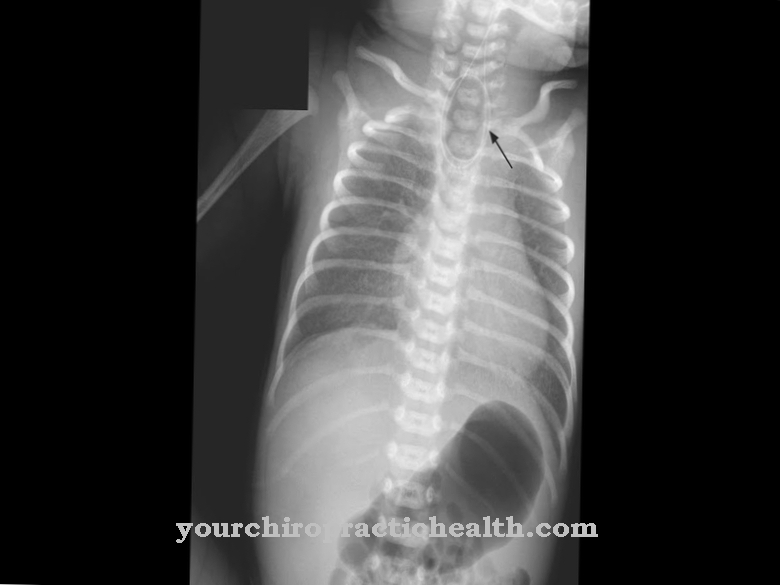Thalassemia is a genetic blood disease with a malformation of the red blood pigment. The result is anemia ("anemia") that must be treated for life. A bone marrow transplant can also help in the case of a fully developed disease of thalassemia.
What is Thalassemia?

© designua - stock.adobe.com
Thalassemia is a hereditary form of anemia ("anemia"). The disease is also based on its geographic occurrence Mediterranean anemia but is also common in north and west Africa, as well as in the Middle East and South Asia. Leptocytosis is another term for thalassemia.
The genetic deviation (mutation) affects the synthesis of the red blood pigment in the body. This "hemoglobin" consists of 2 proteins, the alpha and beta chains. 2 alpha and 2 beta units form a hemoglobin unit that carries the iron-containing heme group in the center and binds the oxygen.
Thalassemia means that the proteins of the hemoglobin are changed compared to the "norm". This results in a reduced oxygen supply to the organism and a disturbed metabolism of the red blood cells (erythrocytes) in thalassemia.
causes
The Thalassemia is a collective term for a variety of mutations in the hemoglobin genes. There are 2 basic forms that are differentiated based on the protein components concerned:
1) Beta thalassemia: The genes of the beta chains of hemoglobin are faulty. The geneticists identified thousands of mutations, most of which are molecular defects in DNA (hereditary molecule). In addition, chromosome breaks (deletions) are a cause of the clinical picture. The major form of thalassemia is the most severe. This occurs when the "diseased" chromosome is contributed by both parents.
If only one parent's chromosome is defective, the minor form develops (every person has a double set of chromosomes because he Nuclear organelles received from father and mother). Besides if intermediate forms of beta-thalassemia are realized, this is the case Intermedia type the moderate, the minor form the symptom-free variant.
2) Alpha Thalassemia: The genes of the alpha chains of hemoglobin are faulty. The gene is present in four ways, so the severity of alpha thalassemia depends on how many of the genes are defective.
By far the most common variant is the beta form, while the alpha type is a rare form of thalassemia.
Symptoms, ailments & signs
There are several forms of thalassemia. A distinction is made between thalassemia major, thalassemia intermedia and thalassemia minor. Thalassemia major shows symptoms of anemia (anemia), in the most common cases in the first year of life. These symptoms may include paleness, tiredness, poor drinking, or a fast pulse (tachycardia).
In some cases, hemolysis, the breakdown of red blood cells, and enlargement of the liver and spleen occurs. Further symptoms of thalassemia major are iron overload or failure to thrive, i.e. impaired overall physical development of the child. If left untreated, secondary symptoms can occur, such as bone deformations that can be seen especially on the face, infectious diseases, failure to thrive or death.
Symptoms of thalassemia intermedia may be similar to those of thalassemia major. In addition, the following symptoms also appear: thromboses, ulcers, gallstones, high blood pressure in the pulmonary vessels, tumors outside the bone marrow. Thalassemia intermedia can occur in both children and adults and manifests itself symptomatically in various forms.
If left untreated, the disease can develop like thalassemia major. Thalassemia minor shows mild or no symptoms of anemia and is therefore the weakest form. In some cases, iron deficiency can occur, and clinically, life expectancy is normal.
Diagnosis & course
A Thalassemia the doctor first recognizes this with a microscopic examination of a blood sample. The erythrocytes are only slightly reddish in color and smaller than in healthy people, and the blood laboratory reveals that the hemoglobin concentration is too low.
With the process of gel electrophoresis, the components of hemoglobin are separated and identified. This is usually followed by lifelong therapy, because the liver and spleen are enlarged in babies. In the course of a thalassemia, adolescents suffer from a general failure to thrive with underdevelopment of the organs and malformations of the skeletal system.
If left untreated, Mediterranean anemia leads to severe cardiac insufficiency, underactive liver and diabetes from an early age. The side effects of therapy in the context of thalassemia are also in need of treatment.
Complications
Thalassemia can have a number of complications. There is a risk of serious effects. Iron overload is one of the most common sequelae of thalassemia. This means that there is an excess of iron in the organism either due to the disease itself or a large number of blood transfusions as part of the treatment.
The excess of iron increases the risk of heart damage. The same applies to the liver and the endocrine system. It has glands that produce hormones that are important for regulating various body processes. Another possible consequence is splenomegaly. This leads to an enlargement of the spleen, which in turn increases the risk of a ruptured spleen.
In previous years, a splenectomy was often performed for this reason. If the spleen has to be removed, people are more likely to get infections. Bone deformities are also one of the consequences of thalassemia. The bones are enlarged due to the disease, which in turn leads to defects in the bone structure. The bones of the face and skull are particularly affected. Because the bones also become thin and brittle, there is a risk of fractures even with minor injuries.
Other serious complications can be heart failure or liver failure. They are the result of hemosiderosis, which damages the heart muscles and liver tissue. Because the islet cells in the pancreas are also affected, there is a risk of diabetes mellitus.
When should you go to the doctor?
A medical examination and treatment should always be carried out for thalassemia so that there are no further complications. A doctor should be consulted with the first symptoms of this disease so that there are no further symptoms. Early treatment always has a positive effect on the further course of the disease.
As a rule, a doctor should be consulted in the case of thalassemia if the person concerned is very tired or very pale. These complaints usually cannot be compensated for with the help of sleep or recovery and do not go away on their own. In addition, poor drinking can indicate thalassemia and should definitely be examined by a doctor. It is not uncommon for those affected to have high blood pressure or suffer from a significant enlargement of the spleen and liver. If these symptoms occur, a doctor must be consulted in any case.
Usually, thalassemia can be diagnosed by a general practitioner. Further treatment depends on the underlying disease and is carried out by a specialist. The further course of the disease also depends heavily on the time of diagnosis.
Treatment & Therapy
Thalassemia must be treated as early as babies, this is especially true for the fully developed clinical picture of the major type. Those affected need blood transfusions every month to compensate for the lack of effective hemoglobin.
However, the blood reserves lead to an accumulation of iron, which the body cannot completely excrete. The deposition of metal ions in various organs such as the heart, liver and pancreas can cause damage that must be avoided. Therefore, the patients are given medication to drive out the excess iron.
Surgical removal of the spleen used to be standard therapy for thalassemia. Today this procedure is only considered a last resort, because the resulting dysfunction of the immune system additionally affects the patient. In terms of causal therapy, there is the option of bone marrow transplantation.
The stem cells from healthy individuals can then generate fully functional erythrocytes in the patient's body. From an evolutionary point of view, the partial or total immunity to malaria in people with thalassemia syndrome is remarkable.
prevention
Thalassemia As a genetic disease, it is very problematic in prophylaxis. One chance to avoid Mediterranean anemia is to clarify the genetic factors of a couple in advance of pregnancy. If the risk is too high, the desire to have children can be reconsidered. Although eugenic measures are carried out in some countries, the abortion practice presents many people with ethical problems with regard to the clinical picture of thalassemia.
Aftercare
Affected people have to have their whole body examined once a year because the absorption of excess iron can lead to permanent damage to the body. Affected people are advised to permanently join a self-help group. There experiences and ways of dealing with the disease can be exchanged. Those affected do not have to feel alone with the disease and can find out other opinions on the way of life with the disease.
It is also advisable to go to permanent psychological counseling in order to learn to live with the disease. Those affected should pay particular attention to a healthy lifestyle. This includes a balanced diet rich in vitamins and avoiding alcohol, nicotine and drugs. If possible, those affected should exercise.
This strengthens the metabolism and the immune system. Sport also has a positive effect on the well-being of those affected. As life with the disease can be very limited, close contact with family and relatives is recommended. These can accompany those affected on their way and support them in everyday activities. Social contact with relatives should therefore be particularly cultivated.
You can do that yourself
This disease can in principle be treated, but it requires a high level of compliance on the part of the patient. If a stem cell transplant is not possible, he must also regularly take medication in addition to the transfusions to remove excess iron. There are various drugs available for this purpose on the market that have to be taken differently and also have different side effects. The affected patient has to learn to live with these sometimes considerable side effects. In addition, he must undergo a complete examination at least once a year, because the drugs that remove the iron can also cause permanent damage.
Those affected find support in self-help groups or associations, such as the IST e.V. (www.ist-ev.org) association, which sees itself as a contact for both doctors and patients and their relatives. The Stefan Morsch Foundation (www.stefan-morsch-stiftung.com) also supports those affected with information and actively helps in the search for stem cell donors.
Thalassemia patients should pay attention to a balanced diet and a healthy lifestyle and avoid stimulants such as alcohol and nicotine. Exercise is advisable as far as possible, because exercise activates the immune system and metabolism. At the same time, exercise improves the mood. Since the quality of life can be very limited, especially with the most severe form of the disease, thalassemia major, those affected may be helped by accompanying psychotherapeutic treatment.

.jpg)



.jpg)





















